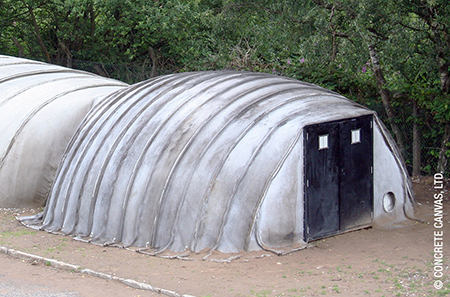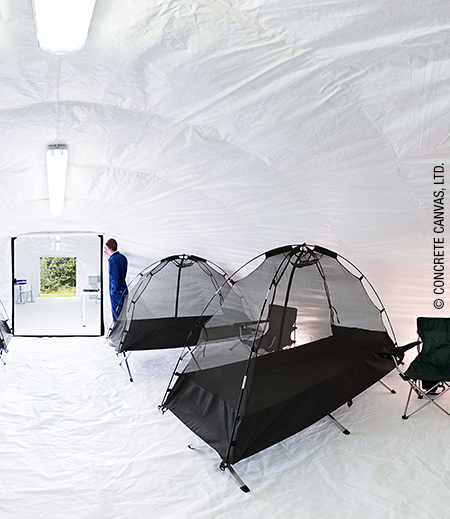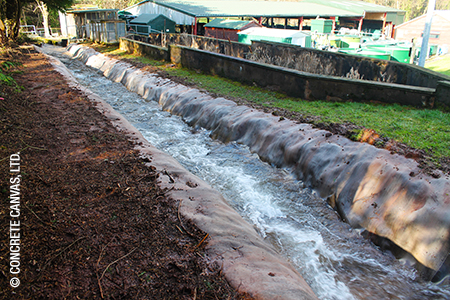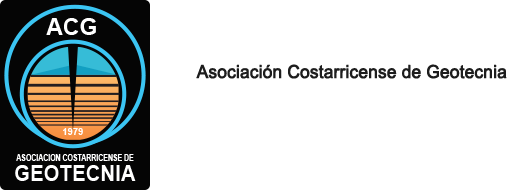Noticias
OCT 13 2015 l asce l Kevin Wilcox
Concreto inflable, una nueva opción para obtener refugios de concreto en un tiempo muy corto

When wetted, the inflatable concrete structure forms a structural shell, with the joints functioning
as stiffening ribs. © Concrete Canvas, Ltd.
Inspired by plaster casts, a U.K. company has developed a concrete-impregnated fabric that can be used to create inflatable buildings.
When one thinks of concrete, "inflatable" isn't one of the first words that comes to mind. Yet two engineers in the United Kingdom have developed and are marketing an inflatable structure that forms a robust concrete shell once hydrated.
The structure is the latest application of a technology called concrete canvas geosynthetic cementitious composite mats, or CC, a product originally developed to create shelters and that now is finding extensive use in civil engineering applications. It is a material that is impregnated with concrete and shipped to the site dry and hydrated once in position. The chemical reaction between the concrete dust and the water forms a hard concrete shell.
"The idea was inspired by some work we did with a material called Modrock-a wettable plaster cloth used to make plaster casts for broken limbs," said Peter Brewin, one of the engineers who developed the technology and a director of the company that produces it, Concrete Canvas Ltd., of Pontypridd, Wales. Brewin submitted written answers to questions posed by Civil Engineering online. "We developed the CC to enable us to engineer inflatable concrete canvas shelters [CCS] because we needed a way to form a thin, uncracked concrete layer that could be stored dry and wetted in an uncontrolled manner."
Brewin said that the inflatable buildings can be deployed as quickly and easily as a tent—by two people in less than an hour—and is ready to use in less than a day. "But at the same time, it provides the advantages—protection, insulation, and durability—of a permanent concrete building that will easily last for more than 25 years," he explained.
The CCS is unfolded on-site and inflated, and then the outer surface is wetted extensively. It reaches 80 percent strength and is ready to use in just 24 hours. "The CCS is a structural shell, with the joints functioning as stiffening ribs to ensure the structure remains in a parabolic, compressive shape when subjected to nonuniform loads, such as snow or wind loading," Brewin said. It was designed to serve the needs of the military and humanitarian groups. A sealed plastic inner layer means that the structure can be sterilized, making it suitable for use as a field hospital, for example.

A sealed plastic liner means the shelter can be sterilized, making it usable as a field hospital. © Concrete Canvas, Ltd.
The CCS fills a gap between a tent and a more permanent structure in situations in which time is of the essence. In military applications, the CCS can be covered in sand to provide enhanced protection from small arms fire. There are two sizes of CCS available, the largest having 50 m 2 of internal area, and several units can be docked together to create larger structures. The units require no special foundations, but the company recommends a flat site free of rocks.
Brewin and fellow company director Will Crawford began developing the CC mat technology at the Royal College of Art in London in 2004. In their design, a three-dimensional fiber matrix impregnated with a dry concrete mix is sandwiched between a lower layer of waterproof polyvinyl chloride and a top layer of porous fibers. The material controls the volume of water as it is added, making it impossible to overhydrate. The fibers increase the material's tensile strength and prevent crack propagation.
One of the greatest challenges that the team faced in developing the material was moving from prototype to production. "There was no suitable equipment in existence that could be used to produce the material," Brewin explained. "This meant that the majority of the production equipment had to be developed from scratch."
But now that the process for producing the material has been improved, the mats are being exported to more than 40 countries worldwide. In addition to being part of the new inflatable shelters, the material has already been used on its own in such applications as drainage-ditch lining, slope protection, and embankment lining and remediation. The material is highly resistant to abrasion and chemical erosion and yet is more environmentally friendly than conventional concrete, according to Brewin. "It is currently used primarily for erosion control, often as a substitute for shotcrete, [because] it can be installed more easily and much faster," Brewin said. He added that that there are many new applications the company is pursuing. This autumn the company is releasing a new product for containment applications, for example.

Civil engineering applications for Concrete Canvas include drainage ditch lining and slope protection. © Concrete Canvas, Ltd.
"We are working on techniques for using CC in remediation applications where [it] can be used to reline existing concrete channels as a much faster, lower-cost, and less environmentally damaging solution to replacing aging infrastructure," Brewin said.
|








